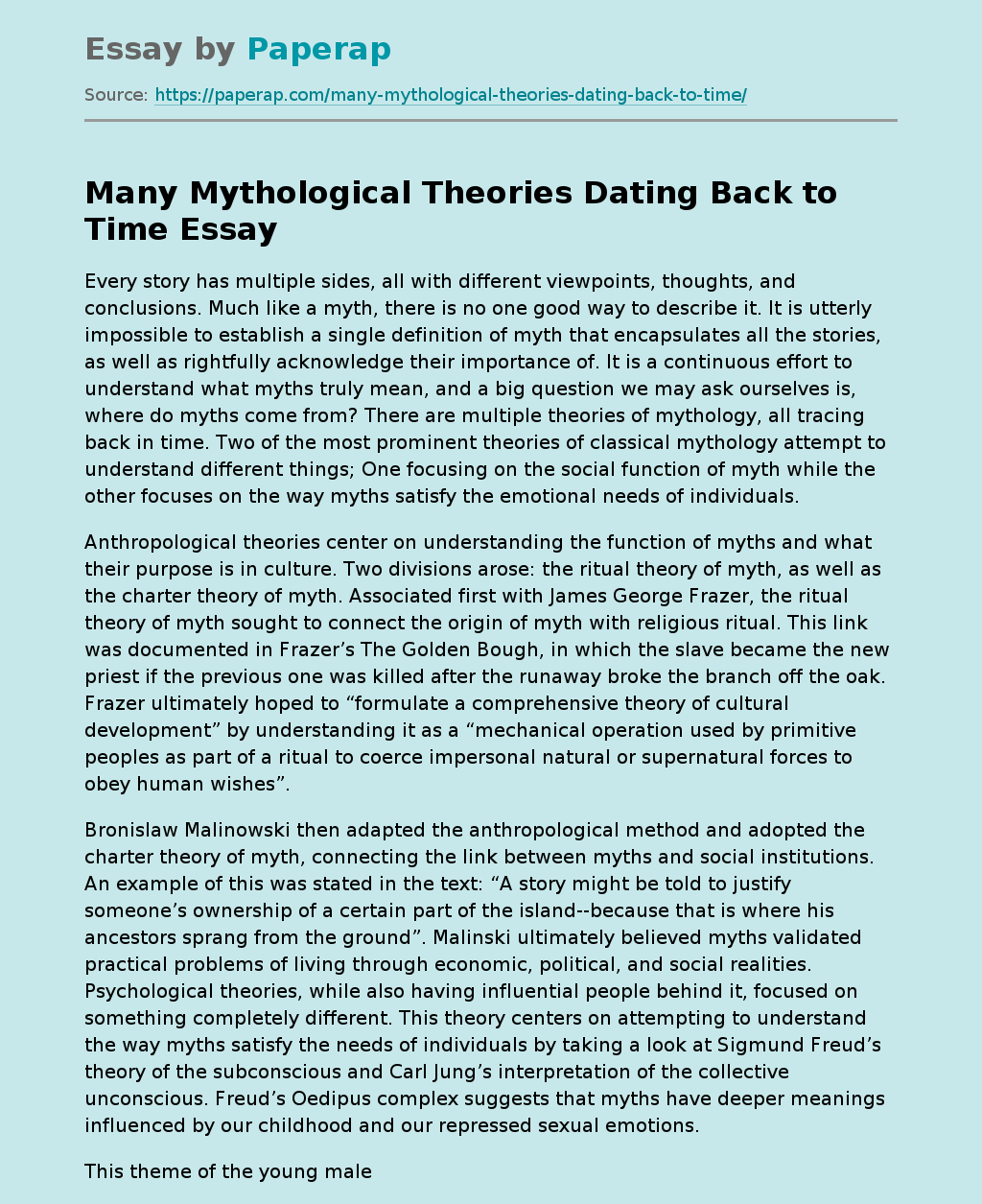Every story has multiple sides, all with different viewpoints, thoughts, and conclusions. Much like a myth, there is no one good way to describe it. It is utterly impossible to establish a single definition of myth that encapsulates all the stories, as well as rightfully acknowledge their importance of. It is a continuous effort to understand what myths truly mean, and a big question we may ask ourselves is, where do myths come from? There are multiple theories of mythology, all tracing back in time.
Two of the most prominent theories of classical mythology attempt to understand different things; One focusing on the social function of myth while the other focuses on the way myths satisfy the emotional needs of individuals.
Anthropological theories center on understanding the function of myths and what their purpose is in culture. Two divisions arose: the ritual theory of myth, as well as the charter theory of myth. Associated first with James George Frazer, the ritual theory of myth sought to connect the origin of myth with religious ritual.
This link was documented in Frazer’s The Golden Bough, in which the slave became the new priest if the previous one was killed after the runaway broke the branch off the oak. Frazer ultimately hoped to “formulate a comprehensive theory of cultural development” by understanding it as a “mechanical operation used by primitive peoples as part of a ritual to coerce impersonal natural or supernatural forces to obey human wishes”.
Bronislaw Malinowski then adapted the anthropological method and adopted the charter theory of myth, connecting the link between myths and social institutions.
An example of this was stated in the text: “A story might be told to justify someone’s ownership of a certain part of the island–because that is where his ancestors sprang from the ground”. Malinski ultimately believed myths validated practical problems of living through economic, political, and social realities. Psychological theories, while also having influential people behind it, focused on something completely different. This theory centers on attempting to understand the way myths satisfy the needs of individuals by taking a look at Sigmund Freud’s theory of the subconscious and Carl Jung’s interpretation of the collective unconscious. Freud’s Oedipus complex suggests that myths have deeper meanings influenced by our childhood and our repressed sexual emotions.
This theme of the young male figure’s sexual desire for his mother and jealousy of his father is shown in stories that “describe heroes slaying dragons and marrying maidens” because they “echo the son’s repressed desire to kill his father (= the dragon) and have sexual intercourse with his mother. It was later discovered that the same theme was apparent in young women as well, titled the Electra complex. Freud also focused on dreams and saw them as having deeper, possibly repressed feelings that we may be trying to conceal. As stated in the text, “The individual’s dreams reflect the same primitive mode of consciousness that we find in myth, which are collective dreams preserved from the primitive childhood of the race”. Freud is stating that dreams are like myths; They appear to have an obvious content but have latent meanings as well.
Continuing to explore our subconscious mind, Carl Jung adopted the term, collective unconscious, to represent the unknown thoughts and desires we as a society and as humankind may have. This is based off archetypes, a recurrent symbol in which we base our myths from. A few examples were mentioned in the text including the Wise Old Man, the Earth Mother, and the Divine Child. While some people find the anthropological theory of interpretation as too narrow, I find it to be most convincing. Both theories have multiple strengths and weaknesses, but the anthropological theory is much more simple because it is very functionalist. The psychological theory is a bit more extravagant, as well as more subjective making it not as concrete and much more complicated.
The psychological theory focuses on emotional and personal recollections, while the anthropological theory excludes these things and maintains focus on the collective ideas and the myths surrounding people and regions around the world. However, I think our minds are powerful things and our subconscious isn’t something we should ignore when talking about myth. In conclusion, classical mythology is too complex to be summarized and explained by one myth. By understanding the several interpretations, we can get a wide insight into the different theories behind myth to help us understand them. As stated in the book, Classical Mythology: Ninth Edition, “A classical myth is a story that, through its classical form, has attained a kind of immortality because its inherent archetypal beauty, profundity, and power have inspired rewarding renewal and transformation by successive generations”.
Many Mythological Theories Dating Back to Time. (2021, Dec 14). Retrieved from https://paperap.com/many-mythological-theories-dating-back-to-time/

